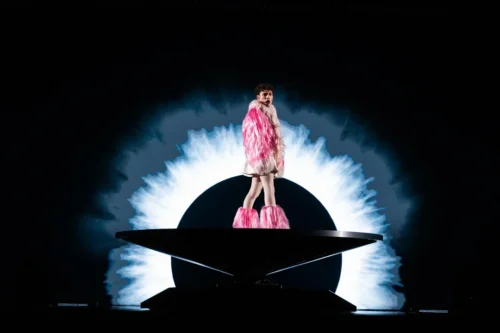It’s Tuesday, December 16, 2025. Time for another weekly update! The Eurovision world saw major developments this week as the path to Vienna 2026 takes shape. Iceland shocked fans by withdrawing from the Contest, while Poland confirmed its participation despite controversy. Portugal’s plans sparked internal debate, and the EBU’s Eurovision director reached out to address fan concerns. Meanwhile, we got our first glimpse of the Eurovision 2026 stage design. National selection season is also heating up across Europe with new song releases and lineup announcements from Luxembourg to Azerbaijan. And in a bold protest, a Eurovision legend joined the reigning champion in returning their trophies. Here are this week’s top stories: Eurovision 2026 Updates 📷 The participating countries. source: Eurovision 🇮🇸 Iceland: Broadcaster Withdraws from Eurovision 2026 Iceland’s broadcaster RÚV has confirmed the country will not take part in Eurovision 2026. RÚV joins a boycott with other nations. The decision comes in protest of the EBU allowing Israel to participate despite the ongoing conflict. Iceland follows Ireland, Spain, the Netherlands, and Slovenia in withdrawing from next year’s contest. This marks the first time Iceland sits out Eurovision since 1998. RÚV’s announcement cited aligning with those countries taking a stand over “events in the Middle East”. Herwith they reflect significant political pressures around the 2026 contest. source: RÚV 🇵🇱 Poland: TVP Confirms Participation Despite Boycotts Poland’s public broadcaster TVP has decided it will participate in Eurovision 2026. In an official statement, TVP acknowledged “the scale of tensions” surrounding the upcoming edition and said it understands the strong emotions involved. However, the Polish broadcaster is “giving Eurovision a chance” to remain a space filled with music – and only music. TVP noted it is siding with the majority of EBU members by staying in the contest. Poland’s confirmation comes after internal deliberations. The country will move forward with its selection process, aiming to focus on the song rather than politics. se.pl 🇵🇹 Portugal: RTP Stands Firm Amid Boycott Calls In Portugal, Eurovision has sparked intense debate. Seventeen artists competing in Festival da Canção 2026 (Portugal’s national final) signed a joint statement vowing to boycott Eurovision if they win, unless Israel is barred. They argue they “do not accept complicity in human rights violations,” referencing that Israel was not excluded despite United Nations accusations. In response, broadcaster RTP publicly reaffirmed it will participate in Eurovision 2026 regardless. RTP said that,regardless of the artists’ choices, it will hold Festival da Canção and send an entry to Vienna. This stance drew criticism. Portugal’s only Eurovision winner, Salvador Sobral, blasted RTP’s decision as “political cowardice”. A public petition urging Portugal’s withdrawal has gathered over 22,000 signatures. Despite the backlash, RTP is proceeding with its selection, even hinting it could send an alternate act if the FdC winner declines source: sabado.pt. EBU Director Martin Green’s Open Letter to Fans Eurovision’s Executive Supervisor Martin Green CBE addressed the fan community in an open letter amid the current controversies. He acknowledged many fans’ “strong emotions” over events in the Middle East and calls for a stance. Green emphasized that the Eurovision Song Contest must remain guided by its rules to keep bringing people together. He pledged that all participating broadcasters will be expected to respect the contest’s rules and values, “and if they don’t… we will not tolerate it”. Green also directly addressed fans from Ireland, Spain, Iceland, Slovenia, and the Netherlands, whose broadcasters withdrew. He said their decisions were made “with great dignity” Green affirmed the EBU’s respect for those choices, and expressed hope that those countries “return to the Contest soon”. Despite the divided world, Green wrote, Eurovision will remain a space where “music takes centre stage” and everyone is welcome, whatever their views are. source: eurovision.com Vienna 2026 Stage Design Unveiled Host broadcaster ORF has revealed the stage design for Eurovision 2026 in Vienna. The stage, designed by the renowned Florian Wieder, centers on a large curved LED “leaf” as its centerpiece, complemented by a sweeping arc and an intricate golden “construct” structure. The concept draws inspiration from the Viennese Secession art movement, aiming to break conventions and foster radical creativity while preserving Eurovision’s familiar DNA. ORF describes the design as a blend of organic and modern elements: the Leaf symbolizes new beginnings, the Curved Line conveys musical movement, and the Construct brings architectural order in contrast. Notably, the Green Room will be directly connected to the stage via a walkway, enabling a dramatic “Winner’s Walk” through the audience for the victors. With state-of-the-art LED surfaces and a nod to Vienna’s artistic heritage, the stage promises to be both functional and visually striking as Europe gathers in May. source: eurovision.com National Finals and Selections 🇱🇺 Luxembourg: Eight Finalist Songs Released Luxembourg has published the songs competing in its much-anticipated national final return. All eight entries for the Luxembourg Song Contest 2026 (LSC 2026) are now available to hear on RTL’s platforms. Two entries are performed in French and the others in English, with some artists also weaving in lyrics from Portuguese and German. The national final will take place on 24 January 2026 at the Rockhal. source: rtl.lu 🇲🇩 Moldova: 12 Finalists Chosen After Auditions In Moldova, the national selection has moved forward with a live audition round. Out of around 36 songs that entered the Selecția Națională 2026 auditions, a jury will pick 5 to 10 songs to advance to the televised final. The audition stage will be held today in Chișinău, was eventful. The finalists will prepare for Moldova’s national final, which is scheduled for 17 January 2026. This is the first time in years the auditions for the Moldovan national final will not be seen live on TV. source: TRM 🇮🇹 Italy: Sanremo 2026 Artists Lineup Revealed In Italy, preparations for the iconic Festival di Sanremo 2026 are in full swing. RAI has announced the lineup of 30 big artists who will compete in the 76th edition of Sanremo. The list of performers was unveiled at the end of November. These 30





